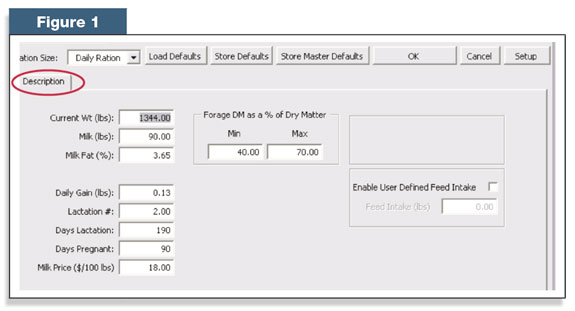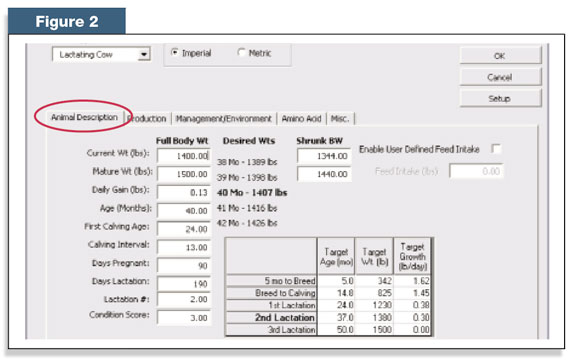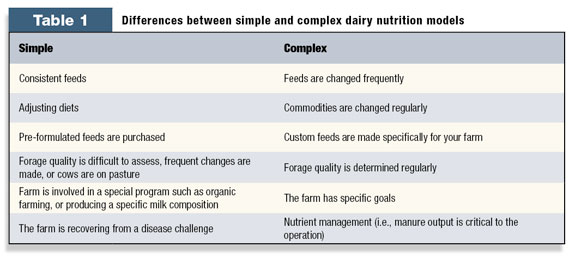How do we determine what nutrients we need to feed a dairy cow? Do you know what goes into balancing your herd’s rations? Do you need to know differences in dairy nutrition models? You most likely will not need to know all the numerous, intricate details of a complicated nutrition model. But it would help your understanding of how nutrition data input into a nutritional model affects your herd’s rations.
Nutrition model crash course
Nutrition models help us predict nutrients the dairy cow needs in her diet to meet our performance criteria. This quick list of calculation equations is only the beginning when it comes to nutrition platforms.
Nutrition model platforms can incorporate:
- the cow’s maintenance requirements
- the nutrients needed to support milk production
- a calculation to support the growth of a calf during pregnancy
- an energy calculation for activity, like a long walk to the bunk
- digestibility predictions and losses of nutrients during digestion
- protein losses to functions other than milk production, like microbial action in the rumen
Simple programs are based on a series of nutrient requirements established by tried-and-true older programs like NRC (National Research Council) 1989 or the Spartan Ration Balancer. Complex models include the NRC 2001 system, CPM (Cornell, Penn, Miner) or the “Cornell” model and incorporate more nutrient, cow and environmental factors. And, to add to the variety of nutritional platforms, proprietary models are also developed by private companies and range in complexity depending on the developer.
Can you understand nutritional model differences?
Whether a nutritional consultant, a trained feed company representative or your veterinarian balances your rations, they will use a nutritional modeling system that is proven to provide reliable results. Nutrition models, or systems, come in several platforms and range in complexity.
The solution you choose depends on your production and management goals, how much herd information is available and the user’s knowledge. We might refine our rations to reduce nutrient overfeeding, increase nutrient utilization, maximize production or reduce nutrient excretion. Models get more complicated as your demand for accurate animal response increases, as you use varying ingredients and make management changes.
To compare how actual nutritional models might work, let’s assume that your nutritional consultant has constructed rations to work with your forages. You might then be presented with a summary page and a mix sheet. Both of these reports are routinely updated as cow numbers change, as forage dry matter changes or feed ingredients are changed.

Figure 1 illustrates how a simple model is applied. The consulting nutritionist must input all of the values in the “Description” and rations are formulated based only on the information shown.
Rations are formulated using additional information required under the tabs for production, management/environment, amino acids and other factors.
Now compare Figure 1 to Figure 2 . In Figure 2, more detailed information about your herd is required to develop the ration. The feed professional has the opportunity to input a lot more cow, management and environmental data to refine your ration. The ration is no longer based on just the “description.” 
Because programs and models are made available through a nutrition platform or system, it’s difficult to look at the summary page and determine how rations were balanced. As a producer you can’t determine the difference in the summaries without consulting with the nutritionist who is balancing your rations.
So why is the platform the same?
The models just balance rations. The platform, such as our platform used in the illustration, also provide important extras like ingredient maintenance, inventory control and shadow pricing that go beyond the scope of the models. Often feed companies also run their own private programs on platforms like this one to gain access to the extra features not available in their own system.
Is a complex model better than a simple one?
Not necessarily. With a simple model, more of the nutrients are static. The values given to ingredients are constant. Replacing forage with grain in a simple model will always result in high net energy for the diet.
In a complex model, fiber digestibility may decline as starch fermentation reduces pH, and net energy may go up and then plateau as grain increases. A knowledgeable user must have the ability and confidence to predict these events.
Your decision to use a simple or complex model could be based on your confidence in either your own abilities or your nutritionist’s. The more detailed cow response you demand, the more knowledge you need of nutrition and model platform functions.

Table 1 shows examples to help you decide when to use simple or complex models.
Nutrition modeling and the equations and predictions within each model and each platform are complicated. But with a little basic modeling knowledge you can start a conversation with your feed specialist. You may want to ask your feed specialist what kind of model is being used on your farm. You might enjoy the lesson. Your feed specialist might enjoy the challenge. PD

-
Essi Evans
- Dairy Nutritionist/Model Adviser
- Dalex Livestock Solutions
- Email Essi Evans





